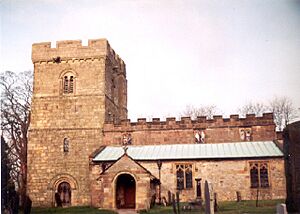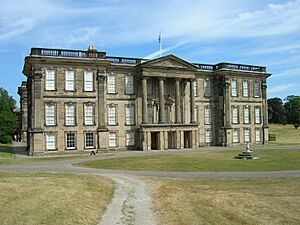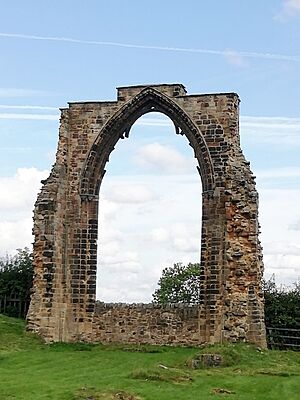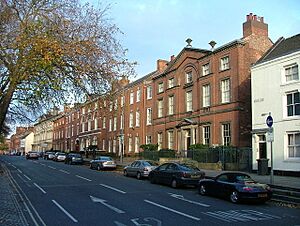List of monastic houses in Derbyshire facts for kids
This article lists the monastic houses that once existed in Derbyshire, England. These were places where groups of religious people, like monks, nuns, or friars, lived together under special rules. They dedicated their lives to prayer, study, and work.
Many of these houses were dissolved, or closed down, in the 1530s during the time of King Henry VIII. Today, only ruins or parts of these old buildings remain.
Alien houses are included, as are smaller establishments such as cells and notable monastic granges (particularly those with resident monks), and also camerae of the military orders of monks (Knights Templars and Knights Hospitaller). Monastic hospitals are included where they had the status or function of an abbey, priory, friary or preceptor/commandery.
- Abbreviations and key
| Symbol | Status |
|---|---|
| None | Ruins |
| * | Current monastic function |
| + | Current non-monastic ecclesiastic function (including remains incorporated into later structure) |
| ^ | Current non-ecclesiastic function (including remains incorporated into later structure) or redundant intact structure |
| $ | Remains limited to earthworks etc. |
| # | No identifiable trace of the monastic foundation remains |
| ~ | Exact site of monastic foundation unknown |
| ≈ | Identification ambiguous or confused |
Locations with names in italics indicate possible duplication (misidentification with another location) or non-existent foundations (either erroneous reference or proposed foundation never implemented) or ecclesiastical establishments with a monastic name but lacking actual monastic connection.
| EH | English Heritage |
| LT | Landmark Trust |
| NT | National Trust |
Contents
Monastic Houses in Derbyshire
What are Monastic Houses?
Monastic houses were communities where people lived a religious life. Monks lived in monasteries or abbeys, and nuns lived in convents or priories. They followed strict rules, often focusing on prayer, farming, and helping their local communities.
Different groups, called "orders," had their own specific rules. For example, the Augustinian Canons Regular were priests who lived in communities, while Benedictine nuns were women who lived apart from the world. Knights Hospitaller were a military-religious order who also cared for the sick.
A Look at Derbyshire's Monasteries
Here's a list of some of the important monastic sites in Derbyshire. Many of these places have a rich history, even if only small parts of them are left today.
Barrow Camera
This was a property belonging to the Knights Hospitaller, a military-religious order. It was established before 1189. It's thought that the Knights didn't live here for long periods. The site was later connected to Yeaveley before 1433. Today, parts of Arleston House, built in the 16th or 17th century, might include remains of the original building.
Bradbourne Priory
This priory was home to Augustinian Canons Regular. It was founded in 1238 and was likely a smaller part, or "cell," of Dunstable Priory in Bedfordshire. The priory eventually closed down, but the Church of All Saints, Bradbourne, remains.
Breadsall Priory
Another home for Augustinian Canons Regular, this priory was founded between 1220 and 1266. It was closed in 1536. In 1552, the land was given to Henry, Duke of Suffolk. Today, an Elizabethan mansion stands on the site, which became the 'Marriott Breadsall Priory Hotel' in 1980. You can still see a 13th-century arch in the basement of the hotel.
Calke Priory
This priory was also for Augustinian Canons Regular. It was founded around 1131 by Maud, the widow of the Earl of Chester. The canons later moved to Repton Priory between 1153 and 1172. Calke Priory was dissolved in 1538. A large house called 'Calke Abbey' was built on the site later. The priory was dedicated to Saint Giles.
Dale (Stanley Park) Abbey
This site has a long history, starting as a hermitage in the 12th century. It was home to Augustinian Canons Regular and later Premonstratensian Canons. The canons moved here from other abbeys like Tupholme and Welbeck. The abbey managed to avoid being closed in 1536 by paying a large fine, but it was finally dissolved on October 24, 1538. The Abbey Church of the Blessed Virgin Mary, Dale, was its formal name.
Darley Priory
Darley Priory was a daughter house of St Helen's in Derby, home to Augustinian Canons Regular. It was founded around 1146 by Robert de Ferraris. The priory was dissolved on October 22, 1538. An 18th-century house called 'Darley Park' was built on the site, but it was demolished in 1962. Today, a 15th-century building, likely the priory's guest house, is now 'The Abbey Public House'.
Derby Blackfriars
This was a home for Dominican Friars, also known as Blackfriars because of their black cloaks. It was founded before 1239 and dissolved on January 3, 1539. An 18th-century Friary Hotel was built on the site, which later became a public house and is now a nightclub. The friary was dedicated to the Annunciation.
Derby — King's Mead Priory
This priory was home to Benedictine nuns. It was founded between 1149 and 1159 by the abbess of Derby. The priory was dissolved in 1536. The land was given to Francis, Earl of Shrewsbury, in 1543 or 1544. A 16th or 17th-century building now stands on the site. The priory was dedicated to St Mary.
Derby Priory (Augustinian)
This priory was for Augustinian Canons Regular. It was founded in 1137 by Towyne, a citizen of Derby. Most of the monks moved to Darley around 1146, and this site became a smaller "cell" by 1154. It later became a hospital in 1160 and stopped operating before 1360. It was known as The Priory Church of Saint Helen, Derby.
Derby Priory (Cluniac)
This priory was for Cluniac monks. It was a "cell," or smaller part, of Bermondsey Abbey in Surrey. It was founded before 1140. The priory was accidentally destroyed by fire but rebuilt around 1335. By 1395, it became independent from Bermondsey. It was dissolved in 1536. The priory was dedicated to Saint James.
Gresley Priory
This priory was home to Augustinian Canons Regular. It was founded around 1135-1140 by William de Greisley. The priory was dissolved in 1536. The land was granted to Henry Cruche in 1543 or 1544. The nave (main part) of the priory church is still used today as the local church for Church Gresley. It was dedicated to Saint Mary and Saint George.
Lees Priory
This priory was for Augustinian Canons Regular. It might have been a "cell" dependent on Rocester Abbey in Staffordshire. It was likely founded before 1160 and dissolved sometime after 1517. It was also known as 'Leyes Priory'.
Locko Preceptory
This was a St. Lazarus Hospitallers site, which was a military-religious order that also ran a leper hospital. It was founded around 1297 and dissolved in 1375. It was known as The Hospital of Saint Mary Magdalene.
Repton Priory
Repton has a very old religious history. It was first home to Anglo-Saxon monks and nuns in a "double monastery" before 660. This early monastery was destroyed by Danish raids in 874. Later, Augustinian Canons Regular from Calke rebuilt it around 1153-1159. The priory was dissolved on October 25, 1538. Today, parts of the priory are included in the buildings of Repton School, which was founded in 1557. St Wystan's Church on the site also has significant parts of the original Anglo-Saxon foundation.
Yeaveley Preceptory, Stydd
This was another site for the Knights Hospitaller. It was founded around 1136. The preceptory was dissolved in 1535 or 1540. The land was given to Charles, Lord Montjoy, in 1543 or 1544. Some of the original buildings are now part of a farmhouse. The Church of St Saviour was also part of the Hospitallers' property. It was dedicated to St Mary and St John the Baptist.
Other Sites
Beightonfields Priory: This is a country house built between the 17th and 19th centuries. Despite its name, it doesn't have a history as a monastic house.
See also








